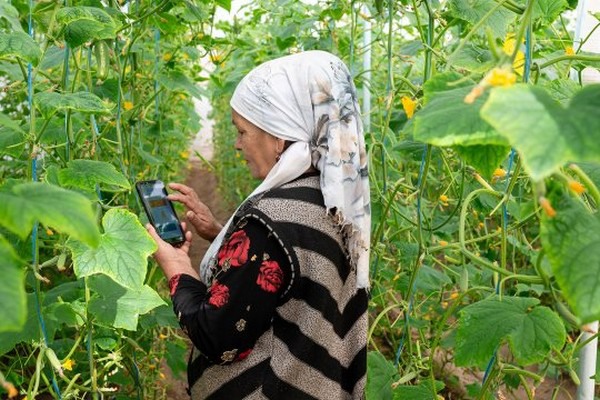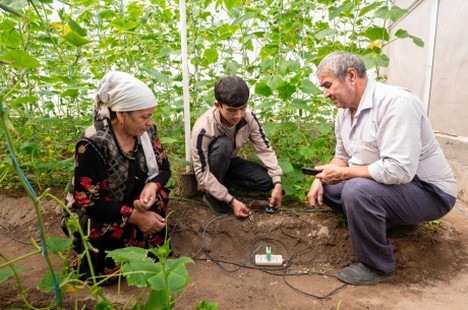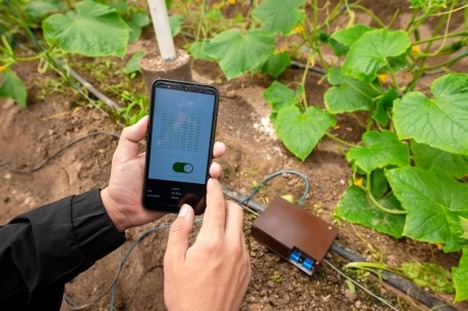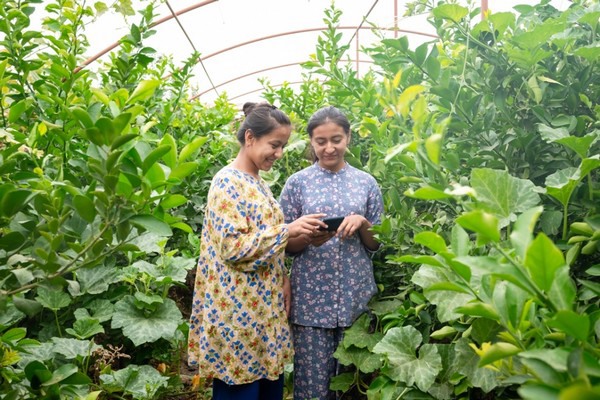Sitting in a field in the heart of Uzbekistan's Fergana Valley, Shaodatkhon Oripova's greenhouse isn't just the simple structure it used to be. It's now alive with digital sensors connected to the internet, through which the 62-year-old farmer can control the temperature, humidity, light, and soil moisture.

"In the past," she said, "a lot of my earnings would disappear into paying for utility bills and buying fertilizers," says the mother of three, whose farm produces herbs, tomatoes, lemons, corn, and clover.
Now, Shaodatkhon can better regulate these inputs through the sensors. If anything needs to be adjusted in the greenhouse, her mobile phone buzzes to alert her.
These sensors were particularly useful over the summer when extreme heat and lack of water impacted production from her greenhouse. While other farmers sustained great losses, she was able to maintain her production at close to last year's levels.
Shaodatkhon has been used to the hard work and highs and lows of farming. "I was born into a family of farmers, and I have been a farmer my whole life, but it has not been easy," she said.
It is a different type of farming now. Shaodatkhon describes how every day is a new learning experience with digital technology. She can now free up more time for other things, such as marketing her produce, spending time with her family, and improving her education and quality of life.
 Smart sensors based on the internet of things are being installed in greenhouses across Uzbekistan's Fergana Valley. Shaodatkhon and her family use these sensors to control temperature, humidity, light, and soil conditions in their greenhouse. ©FAO/Daniil Dolidze
Smart sensors based on the internet of things are being installed in greenhouses across Uzbekistan's Fergana Valley. Shaodatkhon and her family use these sensors to control temperature, humidity, light, and soil conditions in their greenhouse. ©FAO/Daniil Dolidze
Shaodatkhon is one of the farmers taking part in the Smart Farming for the Future Generations project of the Food and Agriculture Organization of the United Nations (FAO). It is closely aligned with the Digital Villages Initiative, which was introduced in the villages of Novkent and Yuksalish in the Fergana Valley of Uzbekistan in 2023.
The Digital Villages Initiative is a flagship program of FAO aiming to transform at least 1,000 villages around the world into digital hubs. The initiative seeks to foster rural transformation and empower communities through digitalization and participatory approaches to combat hunger, poverty, and inequality. The Digital Village Initiative helps farmers access technology to boost production, access rural services, and improve livelihoods.
 "Living labs" allow farmers to exchange information and tips with each other and with experts and innovators, discussing challenges and brainstorming solutions. ©FAO/Valentina Jug
"Living labs" allow farmers to exchange information and tips with each other and with experts and innovators, discussing challenges and brainstorming solutions. ©FAO/Valentina Jug
But it's not just farmers who are getting involved. FAO is also offering training programmes to local young people. A coding camp helped train youth in replicating smart sensor devices. In the culmination of the training programs, a Digital Villages Hackathon took place in November 2023, yielding an array of innovative agritech solutions to the challenges faced by rural people in the Fergana Valley.
The continuation of regular collaborative innovation workshops, known as "living labs," also provides a vital platform for exchange among farmers, experts, and innovators. During these sessions, farmers like Shaodatkhon and her family discuss the challenges they face, for example, heating the greenhouse against the biting winter cold. Other topics brainstormed with a range of local actors and experts have included water scarcity, a lack of infrastructure, and limited access to reliable extension services.

As technologies develop at breakneck speed, Shaodatkhon says she looks forward to further innovations in areas such as smart irrigation and renewable energy solutions for her greenhouse.
FAO is scaling up the Digital Villages Initiative, in Central Asia and beyond, working closely with rural communities to understand their most pressing problems and desired outcomes, identify the agricultural technologies best suited to the community and support them on their digital transformation journeys.
Source: fao.org
